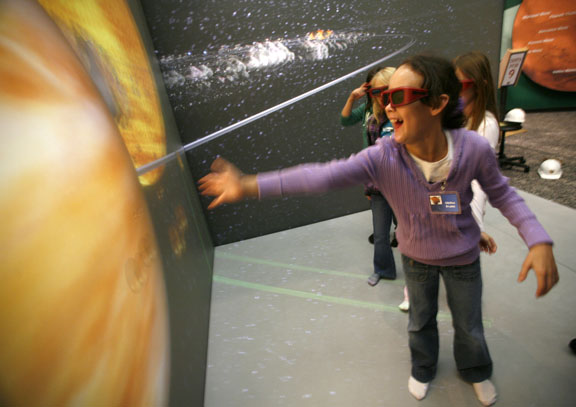
Buckhorn Elementary School (Perry County) 4th-grade student Claudia Abner reaches out to touch Jupiter in a 3-D simulation of the planets at the Challenger Learning Center of Kentucky in Hazard Dec. 3, 2010. Photo by Amy Wallot
By Susan Riddell
susan.riddell@education.ky.gov
Students from Hayes Lewis Elementary School (Leslie County) recently got to name their own comet, while Buckhorn Elementary School (Perry County) students stood on Saturn.
No, they are not participating in a “Students in Space” program, but these and thousands of other Kentucky students are getting hands-on learning at the Challenger Learning Center of Kentucky in Hazard.
“Who knows, we may have a future astronaut in here,” said Glenda Mitchell, a science teacher at Hayes Lewis Elementary. Mitchell was considering that question while watching half her students participate in a simulated space shuttle environment complete with life support, communications, clean room, isolation, medical, remote and navigation stations. Meanwhile, her remaining students monitored systems and communications from the nearby “mission control” room.
While on their mission in space, students encountered an unknown object. Using information gathered at the Navigation Station and with assistance from Challenger Center staff, the students ruled out supernovas, planets, asteroids, meteors, short-period comets and determined the object was a long-period comet. Allowed to further investigate Comet Wolverine (named for the school’s mascot), students exchanged information gathered at various stations.
It ended with a completed mission, a safe landing and knowledge of content.
“This place allows students to use inquiry that they could not in a regular classroom,” Mitchell said. “They can do so many different things here, and they take ownership of the learning. Each child feels the success involved (in the completed mission).
“For us, this place is close to home,” Mitchell added. “We’re far away from a lot of places like this, but we’ve been coming back for many years because the Challenger Center is a great opportunity all around.”
Hayes Lewis Elementary students are in their 12th year attending the center, and Mitchell has been bringing them for 10 of those years.
Director Tom Cravens said there are more than 45 Challenger Centers in the country, including one in Paducah and another one that opened earlier this year in Louisville. The Challenger Learning Center of Kentucky in Hazard conducts roughly 225 missions yearly. That adds up to approximately 6,000 students.
“The vast majority of the students are 4th- through 7th-graders,” Cravens added. “Once summer camps are factored, the center will open its doors to about 10,000 students per year.”
Both attendance and learning at the Challenger Center have increased since Mars Invasion 2030 opened up at the Hazard center three years ago. Coal Education Development and Resources (CEDAR) collaborated on developing the project several years before.
Mars Invasion 2030 is a curriculum-driven program designed to excite and motivate students in science, technology, engineering and mathematics (STEM) subjects. “Coal Camp to Space Camp” is the specific curriculum used in the experience.
Videos, other multimedia elements and written materials lead students through a planning process to inhabit Mars by the year 2030. Students must plan for colonization and address issues concerning food, housing and other necessities.
“There are nine lesson plans teachers use to prepare the students for this learning experience,” Cravens said. “Students also get a good idea about how coal mining and space are alike. That’s something a lot of people don’t think about, but there’s lots of evidence there for a valuable lesson.”
Some of the stations in the Mars Invasion 2030 experience include:
- using a computer to drive a rover
- using clay and tools to make a model of an impact crater
- discussing if Mars has ever had water
- discussing how people lose weight quickly on Mars
- steering with 3D technology
- building a momentum machine
Arguably the most popular station is the 3D solar system simulation that the Buckhorn Elementary and Hayes Lewis Elementary students experienced recently.
The Mars Invasion experience “is every bit core content,” Mitchell said. “It’s an awesome learning tool. Kids are being scientific. They are having so much fun and absorbing tons of core content at the same time.”
Mars Invasion 2030 helped the Challenger Learning Center of Kentucky receive an innovation award from the Challenger Learning Center national organization.
“We’re really proud of the opportunities we are giving students,” Cravens said. “Hopefully, we can continue to do so for many years to come.”
MORE INFO …
Challenger Learning Center of Kentucky
Tom Cravens, Tom.Cravens@kctcs.edu, (606) 487-3050 or (800) 246-7521












Leave A Comment